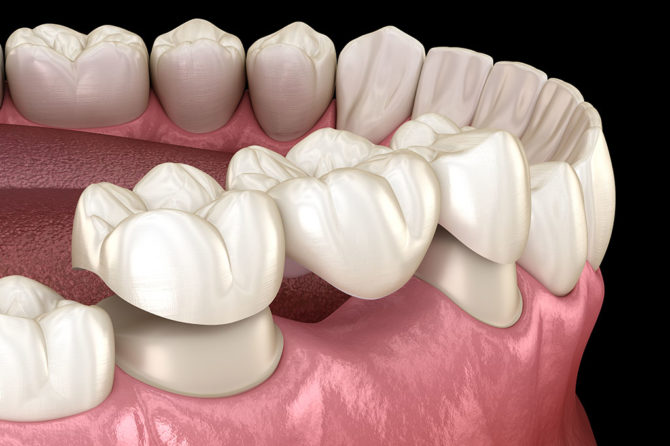
What are dental bridges?
There’s no need to suffer from missing teeth. Today, there are several ways to replace a missing tooth, including dentures, implants and bridges.
Dental implants are usually the first choice to replace missing teeth. This is because they have a few advantages, such as the ability to stop the jaw bone from shrinking. However, in some cases, dental implants aren’t possible. For example, implants can’t be used when the bone loss is too excessive, or when there’s a nerve in the way. In cases like these, a dental bridge is a good option.
In this post, we’ll look at bridges in more detail. We’ll go over the advantages and disadvantages of bridges as well as the different types of bridge.
What is a dental bridge?
A bridge is basically a set of fake teeth. However, they’re not like dentures. You can take dentures out, whereas bridges fix to your teeth with a special glue, so they don’t come out.
Bridges are usually composed of three or more crowns. Each crown is designed to look and work just like a real tooth. The two crowns on the outside either fit over or are bonded to your real teeth.
Types of bridges
Bridges come in several different types:
- Fixed bridge. This is the most common type of dental bridge. It’s good for replacing a missing tooth where there are still two teeth remaining on either side.
- Cantilever bridge. This type of bridge is used where there is only one tooth remaining next to the missing tooth.
Implant-secured bridge. This bridge is used to replace multiple teeth. Two implants hold the bridge into place for maximum stability. - Removable bridge. This type of bridge is used to temporarily hold a space while tissues are healing after surgery.
What are the advantages of bridges?
- Cost. One of the biggest advantages of bridges is that they’re typically cheaper than implants.
- Comfort. Since bridges are fixed in place, they’re typically more comfortable and convenient than dentures.
- One of the best things about bridges is that people get used to them almost right away. You’ll be able to eat and drink as normal straight after the procedure.
What else should I know about bridges?
One of the problems that can occur with bridges is tooth decay and gum disease. Bridges themselves are unsusceptible to these problems – after all, they’re made from inorganic materials. However, your real teeth aren’t. The area where your real teeth meet the bridge is especially susceptible to decay and disease. This means you need to be extra vigilant about cleaning this area.
Another issue with bridges is that the dentist might need to file down your natural teeth to make the crowns fit over them. Your dentist will talk to you about this before the procedure.
Conclusion
If you’re missing a tooth or several teeth, then don’t worry: there are several ways to replace them. Whether it’s with a bridge, an implant, or dentures, the right solution is waiting for you. If you’d like to know more, then make an appointment with your dentist.
Leave a reply
Leave a reply